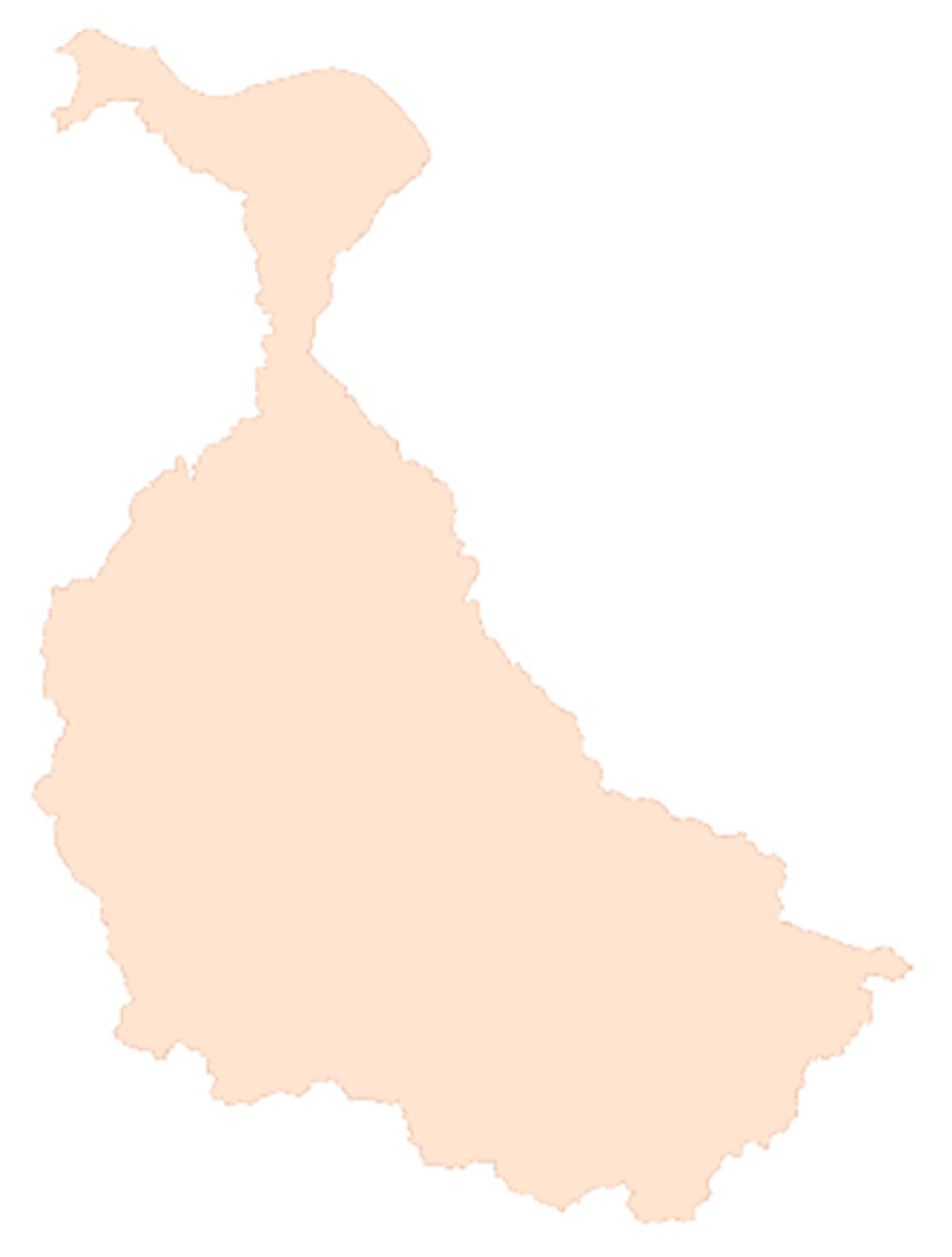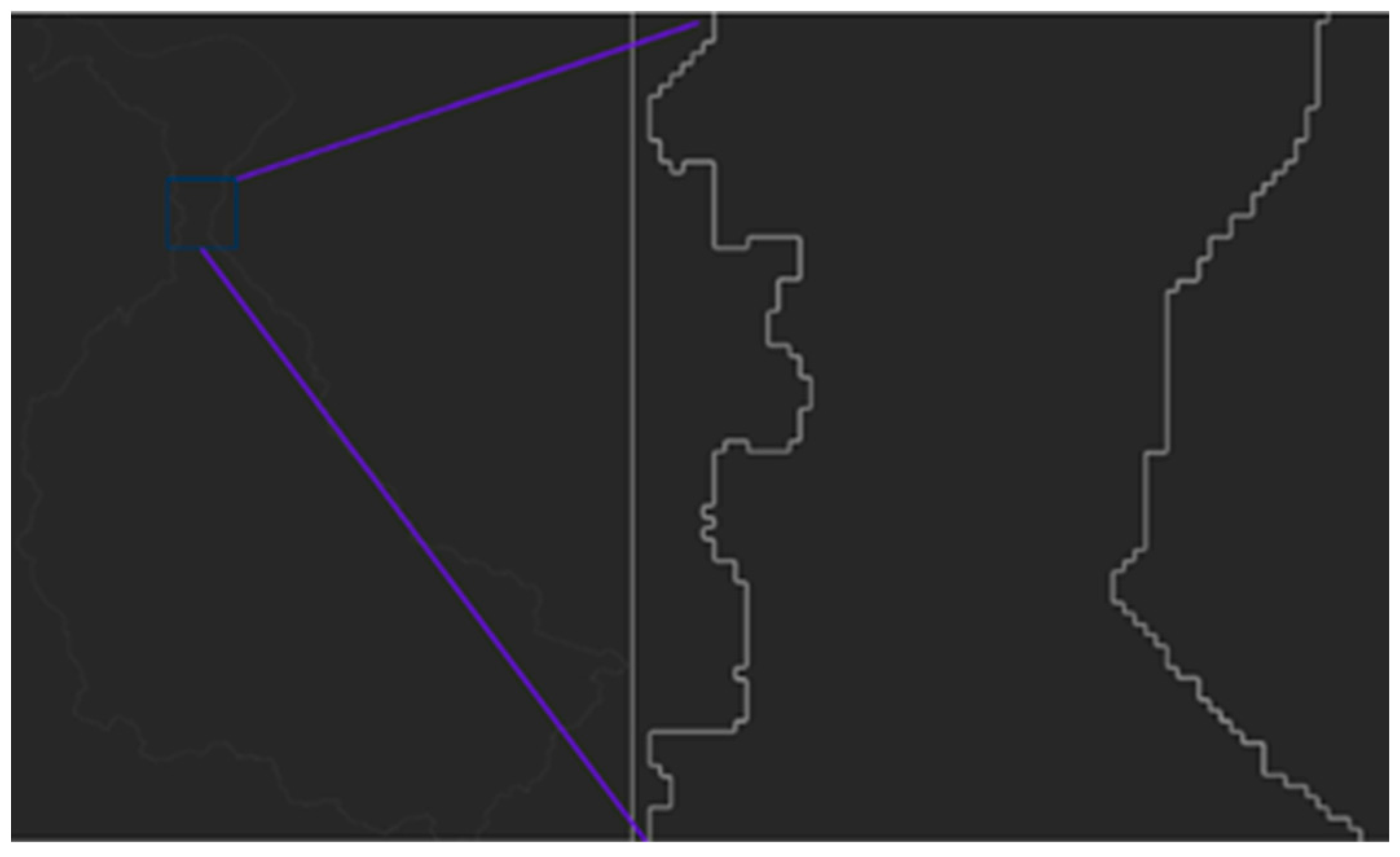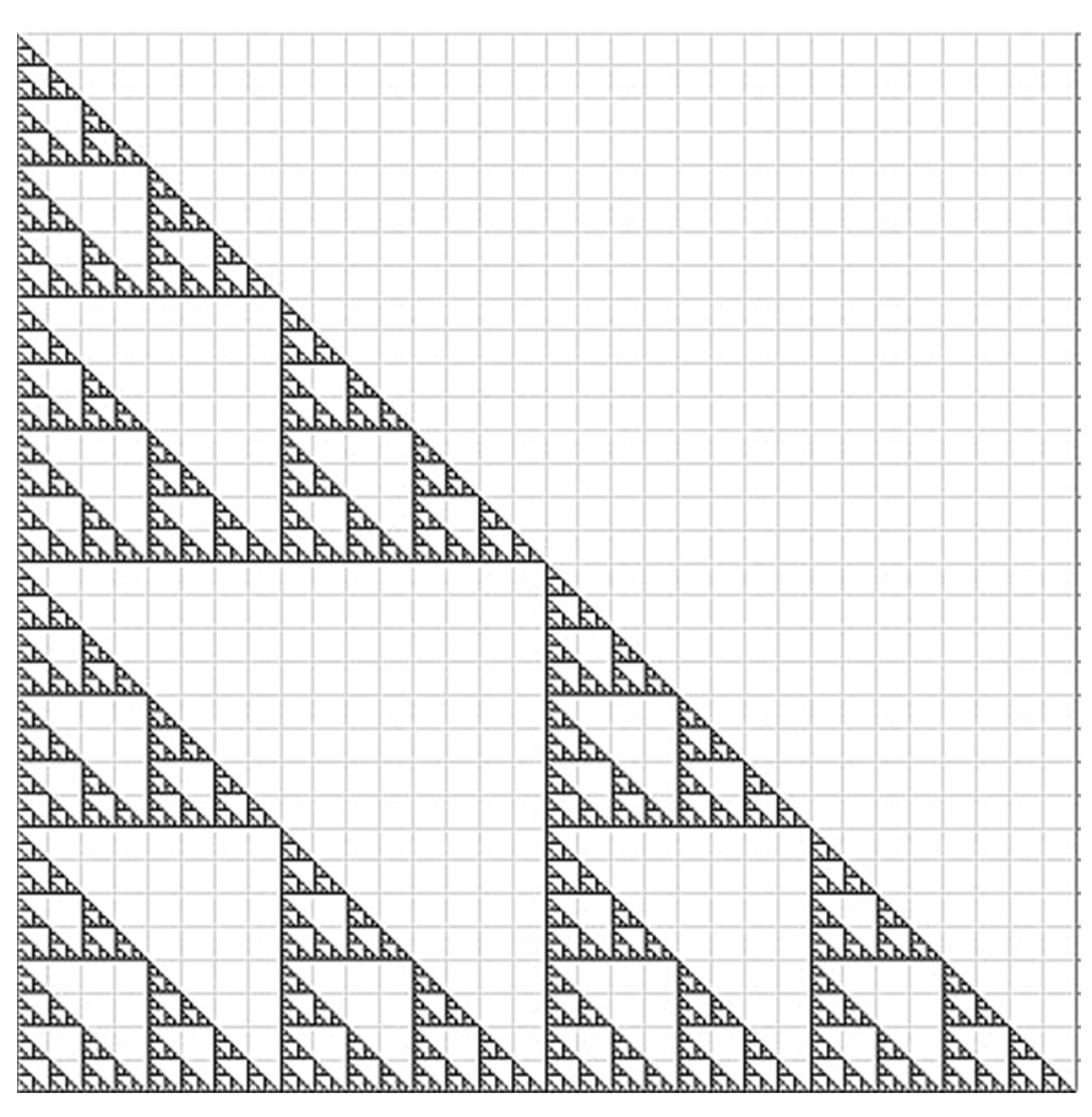Estimation of Citarum Watershed Boundary’s Length Based on Fractal’s Power Law by the Modified Box-Counting Dimension Algorithm
Abstract
1. Introduction
2. Preliminaries
2.1. Number of Segmentations
2.2. Length Estimation Using Yardstick Method
2.3. Fractal Dimension
2.4. Box-Counting Dimension
2.5. Application of Box-Counting Dimension on Sierpinski Triangle
2.6. Application of Box-Counting Dimension on Irregular
2.7. Digital Image
2.8. Edge Detection
- 1.
- Smoothing
- 2.
- Finding gradients
- 3.
- Non-maximum suppression
- 4.
- Thresholding
- 5.
- Edge tracking by hysteresis
3. Materials and Methods
- 1.
- Literature review
- 2.
- Fractal simulations
- 3.
- Modification of box-counting dimension algorithm
- 4.
- Data processing
- 5.
- Canny edge detection
- 6.
- Box-Counting
- 7.
- Calculating dimension
- 8.
- Length estimation
4. Modified Box-Counting Algorithm
| Algorithm 1 Modified Box-Counting Algorithm |
| Input. Input high-resolution image Step 1. Execute the image by Canny Edge Detection Step 2. Convert the black and white image into a binary value Step 3. Find the lowest resolution on the image Step 4. Execute box-counting Step 5. Convert the size of the box into Step 6. Create a linear regression line Step 7. Find the slope |
5. Results
5.1. Power Law Relationship
5.2. Experimental Results
6. Discussion
7. Conclusions
Author Contributions
Funding
Data Availability Statement
Acknowledgments
Conflicts of Interest
References
- Mohajeri, N.; Longley, P.; Batty, M. City Shape and the Fractality of Street Patterns. Quaest. Geogr. 2012, 31, 29–37. [Google Scholar] [CrossRef]
- Mandlebrot, B.B. The Fractal Geometry of Nature; Henry Holt and Company: New York, NY, USA, 1982. [Google Scholar]
- Richardson, L.F. The Problem of Contiguity: An Appendix to Statistics of Deadly Quarrels. Gen. Syst. Yearb. 1961, 6, 139–187. [Google Scholar]
- Mandelbrot, B. How Long Is the Coast of Britain? Statistical Self-Similarity and Fractional Dimension. Science 1967, 156, 636–638. [Google Scholar] [CrossRef] [PubMed]
- Vaughan, J.; Ostwald, M.J. Examining the Position of Wright’s Fallingwater in the Context of His Larger Body of Work: An Analysis Using Fractal Dimensions. Fractal Fract. 2022, 6, 187. [Google Scholar] [CrossRef]
- Husain, A.; Reddy, J.; Bisht, D.; Sajid, M. Fractal Dimension of Coastline of Australia. Sci. Rep. 2021, 11, 6304. [Google Scholar] [CrossRef]
- Li, C.; Xu, Y.; Jiang, Z.; Yu, B.; Xu, P. Fractal Analysis on the Mapping Relationship of Conductivity Properties in Porous Material. Fractal Fract. 2022, 6, 527. [Google Scholar] [CrossRef]
- Zhan, H.; Li, X.; Hu, Z.; Duan, X.; Wu, W.; Guo, W.; Lin, W. Fractal Characteristics of Deep Shales in Southern China by Small-Angle Neutron Scattering and Low-Pressure Nitrogen Adsorption. Fractal Fract. 2022, 6, 484. [Google Scholar] [CrossRef]
- Wen, Z.; Shen, L.; Jing, H.; Fang, K. Color and Shape Grading of Citrus Fruit Based on Machine Vision with Fractal Dimension. In Proceedings of the 2010 3rd International Congress on Image and Signal Processing, Yantai, China, 16–18 October 2010; Volume 2, pp. 898–903. [Google Scholar]
- Mallick, P.K.; Saravana Kumar, S.; Bhoi, A.K.; Sherpa, K.S. Brain Tumor Detection: A Comparative Analysis of Edge Detection Techniques. Int. J. Appl. Eng. Res. 2015, 10, 31569–31575. [Google Scholar]
- Elkington, L.; Adhikari, P.; Pradhan, P. Fractal Dimension Analysis to Detect the Progress of Cancer Using Transmission Optical Microscopy. Biophysica 2022, 2, 59–69. [Google Scholar] [CrossRef]
- Hu, X.; Wang, Y. Coastline Fractal Dimension of Mainland, Island, and Estuaries Using Multi-Temporal Landsat Remote Sensing Data from 1978 to 2018: A Case Study of the Pearl River Estuary Area. Remote Sens. 2020, 12, 2482. [Google Scholar] [CrossRef]
- Husain, A.; Reddy, J.; Bisht, D.; Sajid, M. Fractal Dimension of India Using Multicore Parallel Processing. Comput. Geosci. 2022, 159, 104989. [Google Scholar] [CrossRef]
- Zhu, X.; Cai, Y.; Yang, X. On Fractal Dimensions of China’s Coastlines. Math. Geol. 2004, 36, 447–461. [Google Scholar] [CrossRef]
- Jiang, J.; Plotnick, R.E. Fractal Analysis of the Complexity of United States Coastlines. Math. Geol. 1998, 30, 535–546. [Google Scholar] [CrossRef]
- Carr, J.R.; Benzer, W.B. On the Practice of Estimating Fractal Dimension. Math. Geol. 1991, 23, 945–958. [Google Scholar] [CrossRef]
- Bahramizadeh-sajadi, S.; Katoozian, H.R.; Mehrabbeik, M.; Baradaran-rafii, A.; Jadidi, K.; Jafari, S.; Namazi, H.; Xu, Q.; Eliasy, A. Biocybernetics and Biomedical Engineering A Fractal Approach to Nonlinear Topographical Features of Healthy and Keratoconus Corneas Pre- and Post-Operation of Intracorneal Implants. Fractal Fract. 2022, 6, 688. [Google Scholar] [CrossRef]
- Barnsley, M.F. Chapter V—Fractal Dimension. In Fractals Everywhere, 2nd ed.; Academic Press: Cambridge, MA, USA, 1993; pp. 171–204. ISBN 978-0-12-079061-6. [Google Scholar]
- Cheeseman, A.K.; Vrscay, E.R. Estimating the Fractal Dimensions of Vascular Networks and Other Branching Structures: Some Words of Caution. Mathematics 2022, 10, 839. [Google Scholar] [CrossRef]
- Miloevic, N.T.; Rajkovic, N.; Jelinek, H.F.; Ristanovic, D. Richardson’s Method of Segment Counting versus Box-Counting. In Proceedings of the 2013 19th International Conference on Control Systems and Computer Science, Washington, DC, USA, 29–31 May 2013; pp. 299–305. [Google Scholar]
- Del-Pozo-Velázquez, J.; Chamorro-Posada, P.; Aguiar-Pérez, J.M.; Pérez-Juárez, M.Á.; Casaseca-De-La-Higuera, P. Water Detection in Satellite Images Based on Fractal Dimension. Fractal Fract. 2022, 6, 657. [Google Scholar] [CrossRef]
- Ma, L.; He, S.; Lu, M. A Measurement of Visual Complexity for Heterogeneity in the Built Environment Based on Fractal Dimension and Its Application in Two Gardens. Fractal Fract. 2021, 5, 278. [Google Scholar] [CrossRef]
- Liu, S.; Chen, Y. A Three-Dimensional Box-Counting Method to Study the Fractal Characteristics of Urban Areas in Shenyang, Northeast China. Buildings 2022, 12, 299. [Google Scholar] [CrossRef]
- Kappraff, J. The Geometry of Coastlines: A Study in Fractals. Comput. Math. Appl. 1986, 12, 655–671. [Google Scholar] [CrossRef]
- Husain, A.; Nanda, M.N.; Chowdary, M.S.; Sajid, M. Fractals: An Eclectic Survey, Part-I. Fractal Fract. 2022, 6, 89. [Google Scholar] [CrossRef]
- Yu, X.; Zhao, Z. Fractal Characteristic Evolution of Coastal Settlement Land Use: A Case of Xiamen, China. Land 2022, 11, 50. [Google Scholar] [CrossRef]
- Jaenisch, H.M.; Potter, A.N.; Williams, D.; Handley, J.W. Fractals, Malware, and Data Models. In Proceedings of the Cyber Sensing 2012, Baltimore, MD, USA, 23–27 April 2012; Ternovskiy, I.V., Chin, P., Eds.; SPIE: Bellingham, WA, USA, 2012; Volume 8408, p. 84080X. [Google Scholar]
- Wevers, M.; Smits, T. The Visual Digital Turn: Using Neural Networks to Study Historical Images. Digit. Scholarsh. Humanit. 2020, 35, 194–207. [Google Scholar] [CrossRef]
- Arya, A.; Soni, S. Performance Evaluation of Secrete Image Steganography Techniques Using Least Significant Bit (LSB) Method. Int. J. Comput. Sci. Trends Technol. 2018, 6, 160–165. [Google Scholar]
- Joshi, M.; Vyas, A. Comparison of Canny Edge Detector with Sobel and Prewitt Edge Detector Using Different Image Formats. Int. J. Eng. Res. Technol. 2014, 1, 133–137. [Google Scholar]
- Deng, C.-X.; Wang, G.-B.; Yang, X.-R. Image Edge Detection Algorithm Based on Improved Canny Operator. In Proceedings of the 2013 International Conference on Wavelet Analysis and Pattern Recognition, Tianjin, China, 14–17 July 2013; pp. 168–172. [Google Scholar]
- Wang, C.; Yang, C.; Zhang, H.; Wang, S.; Yang, Z.; Fu, J.; Sun, Y. Marine-Hydraulic-Oil-Particle Contaminant Identification Study Based on OpenCV. J. Mar. Sci. Eng. 2022, 10, 1789. [Google Scholar] [CrossRef]
- Ma, L.; Zhang, H.; Lu, M. Building’s Fractal Dimension Trend and Its Application in Visual Complexity Map. Build. Environ. 2020, 178, 106925. [Google Scholar] [CrossRef]
- Shrivakshan, G.T.; Chandrasekar, C. A Comparison of Various Edge Detection Techniques Used in Image Processing. Int. J. Comput. Sci. Issues 2012, 9, 269–276. [Google Scholar]
- Ticala, C.; Pintea, C.M.; Matei, O. Sensitive Ant Algorithm for Edge Detection in Medical Images. Appl. Sci. 2021, 11, 11303. [Google Scholar] [CrossRef]
- Rana, R.; Verma, A. Comparison and Enhancement of Digital Image by Using Canny Filter and Sobel Filter. IOSR J. Comput. Eng. 2014, 16, 6–10. [Google Scholar] [CrossRef]
- Fahrizal, F. Peta Daerah Aliran Sungai Citarum. Available online: https://www.arcgis.com/home/webmap/viewer.html?webmap=41498213537843899bcbbd3ec9b6d47f (accessed on 29 November 2022).
- Wu, J.; Jin, X.; Mi, S.; Tang, J. An Effective Method to Compute the Box-Counting Dimension Based on the Mathematical Definition and Intervals. Results Eng. 2020, 6, 100106. [Google Scholar] [CrossRef]
- Koukouvelas, I.K.; Pe-Piper, G.; Piper, D.J.W. The Relationship between Length and Width of Plutons within the Crustal-Scale Cobequid Shear Zone, Northern Appalachians, Canada. Int. J. Earth Sci. 2006, 95, 963–976. [Google Scholar] [CrossRef]
- Hashmi, M.H.; Koloor, S.S.R.; Abdul-Hamid, M.F.; Tamin, M.N. Fractal Analysis for Fatigue Crack Growth Rate Response of Engineering Structures with Complex Geometry. Fractal Fract. 2022, 6, 635. [Google Scholar] [CrossRef]





| 1 | 3 | |
| 2 | 9 | |
| 3 | 27 | |
| Size | Number of Boxes | Size | Number of Boxes |
|---|---|---|---|
| 2 | 375,200 | 128 | 304 |
| 4 | 97,300 | 256 | 119 |
| 8 | 26,070 | 512 | 42 |
| 16 | 7407 | 1024 | 15 |
| 32 | 2286 | 2048 | 4 |
| 64 | 789 | 4096 | 1 |
| 0.00012207 | 41,922 | 0.015625 | 295 |
| 0.000244141 | 21,099 | 0.03125 | 140 |
| 0.000488281 | 10,572 | 0.0625 | 63 |
| 0.000976563 | 5281 | 0.125 | 27 |
| 0.001953125 | 2609 | 0.25 | 10 |
| 0.00390625 | 1262 | 0.5 | 3 |
| 0.0078125 | 617 |
| 9.010913347 | 10.64356603 | 1.181186148 |
| 8.317766167 | 9.956980925 | 1.197073917 |
| 7.624618986 | 9.265964276 | 1.215269155 |
| 6.931471806 | 8.571870753 | 1.236659543 |
| 6.238324625 | 7.866722285 | 1.261031248 |
| 5.545177444 | 7.140453043 | 1.287687024 |
| 4.852030264 | 6.424869024 | 1.324160954 |
| 4.158883083 | 5.686975356 | 1.367428524 |
| 3.465735903 | 4.941642423 | 1.425856603 |
| 2.772588722 | 4.143134726 | 1.494319981 |
| 2.079441542 | 3.295836866 | 1.584962501 |
| 1.386294361 | 2.302585093 | 1.660964047 |
| 0.693147181 | 1.098612289 | 1.584962501 |
Disclaimer/Publisher’s Note: The statements, opinions and data contained in all publications are solely those of the individual author(s) and contributor(s) and not of MDPI and/or the editor(s). MDPI and/or the editor(s) disclaim responsibility for any injury to people or property resulting from any ideas, methods, instructions or products referred to in the content. |
© 2023 by the authors. Licensee MDPI, Basel, Switzerland. This article is an open access article distributed under the terms and conditions of the Creative Commons Attribution (CC BY) license (https://creativecommons.org/licenses/by/4.0/).
Share and Cite
Lim, M.; Kartiwa, A.; Napitupulu, H. Estimation of Citarum Watershed Boundary’s Length Based on Fractal’s Power Law by the Modified Box-Counting Dimension Algorithm. Mathematics 2023, 11, 384. https://doi.org/10.3390/math11020384
Lim M, Kartiwa A, Napitupulu H. Estimation of Citarum Watershed Boundary’s Length Based on Fractal’s Power Law by the Modified Box-Counting Dimension Algorithm. Mathematics. 2023; 11(2):384. https://doi.org/10.3390/math11020384
Chicago/Turabian StyleLim, Michael, Alit Kartiwa, and Herlina Napitupulu. 2023. "Estimation of Citarum Watershed Boundary’s Length Based on Fractal’s Power Law by the Modified Box-Counting Dimension Algorithm" Mathematics 11, no. 2: 384. https://doi.org/10.3390/math11020384
APA StyleLim, M., Kartiwa, A., & Napitupulu, H. (2023). Estimation of Citarum Watershed Boundary’s Length Based on Fractal’s Power Law by the Modified Box-Counting Dimension Algorithm. Mathematics, 11(2), 384. https://doi.org/10.3390/math11020384







